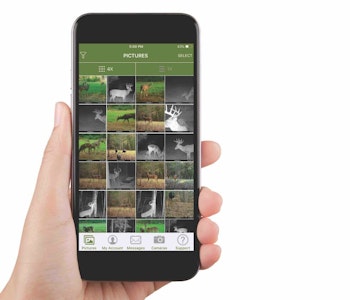Having spent several weeks on the road at trade shows early this year, I continue to be amazed at the advances in technology, especially regarding its application to hunting products. Every year, I ask myself the same rhetorical question: How can bows continue to get better, more advanced? The innovative technologies incorporated into today’s latest bow models are incredible. That said, this year I was dumbfounded by the continued progression of trail camera technology and its application for scouting and hunting.
In recent years, cameras have made incredible gains, providing users with huge megapixel images and 4K video, or both. Most are cellular-capable, sending images to the cloud for data collection. Still, the cellular-capable trail camera is a relatively recent newcomer to the table. However, now every major camera manufacturer has one — or many — in their lineup. To top it off, most now have an accompanying app that catalogs images sent to the cloud from cameras in the field, and that are filterable for data mining purposes.
If you aren’t aware of this technology and where it is heading, here are the basics. Cellular cameras — capable of pushing images to either the cloud or to a central camera that then pushes images to the cloud — are placed in the field. As images are uploaded, most apps now have built-in artificial intelligence processes that automatically sort images by species and sex. In other words, the AI knows if the image is of an elk, deer, coyote, if it is male or female, and so on. Most apps are also capable of including ancillary data such as weather and moon phase with each image. Once uploaded and cataloged, images can be tagged and filtered — in every way imaginable — to return a highly specific set of images. Additionally, some apps do this automatically, providing heat maps of activity and predictive modeling.

For me, this is where the rubber meets the road as it pertains to hunting, and specifically scouting. Of course, I am a self-proclaimed data-driven geek. Imagine the usefulness of being able to filter images from one or a set of cameras that provides several images specific to your query. For example, your search could be for bull elk that score more than 300 inches, on a water source, during the specific dates of the local rut, under a specific moon phase. Of course, there was some manual work tagging those images on your part before being able to make such a query. Still, how much more prepared are you this year with that data in hand than without it?
While this type of innovative technology is welcomed by many hunters, it’s likely opposed by others as well. In fact, some state game agencies have made trail cameras or cellular-capable cameras illegal either completely or at least during specified times of the year. Has technology come too far in this case? Will hunters use it inappropriately, unethically? Only time will tell.
I am of the ilk that the onus should be put on each individual hunter to do what they perceive is ethical. That is just my opinion. I would love to know what other hunters think about this type of technology being used in their local hunting settings. What are your thoughts? Please send me a note and let’s discuss the topic.
As always, if there is a topic you would like to see highlighted or expanded upon in the pages of Bowhunting World, or you would just like to send me a note, please do not hesitate to send an email with your thoughts (darren.choate@grandviewoutdoors.com). Best to you!






